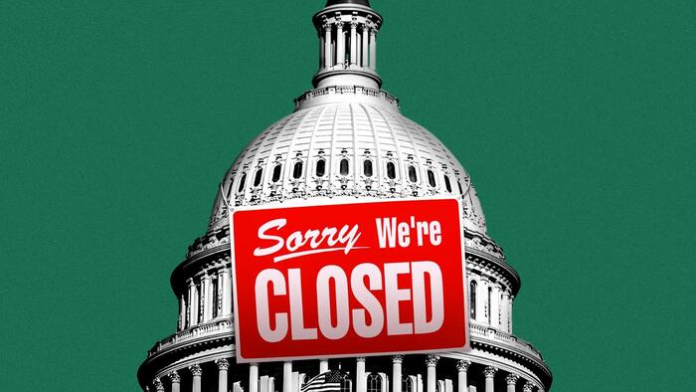Authored by Jack Phillips via The Epoch Times,
The government shutdown that started on Oct. 1 has entered its fourth week and is now the second-longest in U.S. history.
At Day 22 of the shutdown, Democrats and Republicans have remained at odds. Sen. Jeff Merkley (D-Ore.) has been speaking on the Senate floor for more than 17 hours to protest the Trump administration’s policies.
The Senate was scheduled to vote for a 12th time to reopen the government, but Merkley’s speech may derail that vote.
Shutdowns Began in the 1980s
The ongoing shutdown is the second-longest funding lapse in modern history, exceeded by the 35-day shutdown that started in late 2018 and lasted until early 2019. Funding lapse-caused shutdowns are a mostly recent phenomenon, starting in their current format in the early 1980s, according to the House of Representatives’ website.
Before the 1980s, according to the House, “funding gaps did not typically have major effects on government operations. Government agencies would often continue to operate during a lapse in appropriations, with the expectation that funding would be provided in the future.”
That all changed after a series of legal opinions by then-Attorney General Benjamin Civiletti in 1980–1981 suggested that federal agencies had no legal basis to continue operating during funding lapses.
During the 35-day shutdown, Democrats disputed President Donald Trump’s request for billions in federal funding to construct a U.S.–Mexico border wall, a signature issue in Trump’s first presidential campaign. Later, the Senate passed an appropriations bill without any funding for the wall. This came after Democrats took power in the House after the 2018 midterm elections.
A shutdown in 1995 and 1996 lasted 21 days during the administration of President Bill Clinton.
No End in Sight
On Tuesday, Trump said that the GOP won’t “be extorted” by Democratic lawmakers.
Senate Minority Leader Chuck Schumer (D-N.Y.) called on Trump to meet with Democrats on ending the government shutdown.
“Things get worse every day for the American people,” Schumer said at an Oct. 21 news conference before calling for Trump to meet before the president’s trip to Asia. “He should sit down with us” and “negotiate in a serious way before he goes away.”
The House voted 11 times to pass a stopgap measure. On Oct. 20, the Senate again failed to pass a measure to fund the government through Nov. 21. In that vote, three Democrats joined Republicans, but the GOP needed several more to break through the 60-vote threshold.
House Speaker Mike Johnson (R-La.) blamed Democrats during a news conference on Wednesday.
“While it’s already been, as we noted yesterday, the longest full government shutdown in history, Oct. 22 marks another landmark. This is now the second-longest government shutdown of any kind ever, in the history of our country,” Johnson said. “And it’s just shameful. Democrats keep making history, but they’re doing it for all the wrong reasons.”
Democrats say that the government reopening bill needs to include an extension of Affordable Care Act subsidies that expire at the end of the year. Republicans have said that the Obamacare measure should be considered separately.
“The ACA crisis is looming over everyone’s head, and yet Republicans seem ready to let people’s premiums spike,” Schumer said in a floor speech this past week.
Sen. Chris Murphy (D-Conn.), a member of the Senate Appropriations Committee, said this past week that he wouldn’t vote to “move forward on appropriations bills until they’re serious about stopping health care premiums from going up.”
Trump: No Meeting Until Government Reopens
On Tuesday, Trump said that he won’t sit down with Democrats until the government is reopened.
“I would like to meet with both of them, but I said one little caveat, I will only meet if they let the country open,” Trump told reporters, referencing a request by Schumer and House Minority Leader Hakeem Jeffries (D-N.Y.).
Schumer had said that Jeffries and he “reached out to the president today and urged him to sit down and negotiate with us to resolve the health care crisis, address it, and end the Trump shutdown.”
“We urged him to meet with us, and we said we’ll set up an appointment with him any time, any place before he leaves,” they added.
Earlier, Trump said he believed that some Democrats may ultimately break ranks and vote alongside Republicans to end the shutdown in the near future. A similar sentiment was made by his chief economist, Kevin Hassett, who told CNBC that he believes a government funding bill would be passed this week.
Workers Still Furloughed
Thousands of federal workers have been furloughed as federal agencies pared their activities beginning on Oct. 1, the start of the new fiscal year. Simultaneously, about $1.7 trillion in agency operations funding—about one quarter of annual federal spending—expired.
The nation’s 1.3 million active-duty service members got a reprieve. They were looking at missing a paycheck this past week, but Trump ordered the Pentagon to redirect money. Their next paycheck is due on Oct. 31.
The administration is also trying to dismiss thousands of federal workers in agencies that don’t align with its priorities. Republican leaders in Congress have said that’s part of the fallout from a shutdown.
White House budget chief Russ Vought said in an interview on “The Charlie Kirk Show” that many more are planned.
“I think we’ll probably end up being north of 10,000,” Vought said.
A federal judge in San Francisco this past week ordered the government to pause mass layoffs during the shutdown, saying that the cuts appeared to be politically motivated. White House press secretary Karoline Leavitt told reporters that the administration was confident that it would prevail on the merits in subsequent legal action.
Government Shutdown Becomes Second-Longest In US History: 4 Things To Know
RELATED ARTICLES



